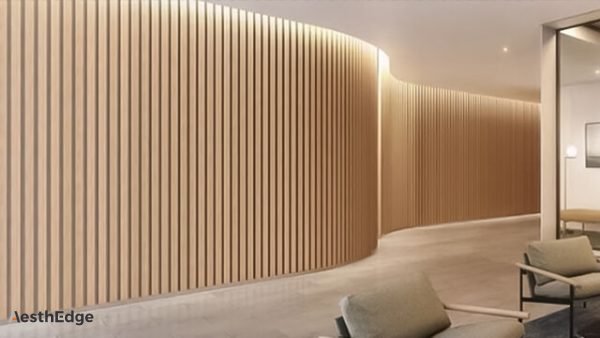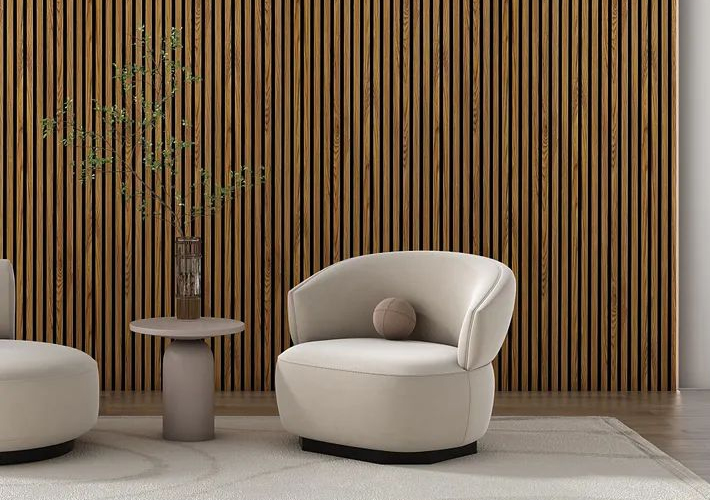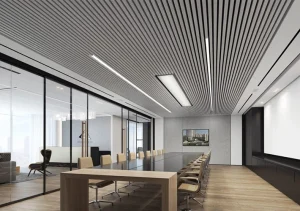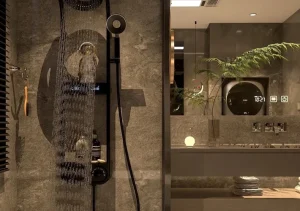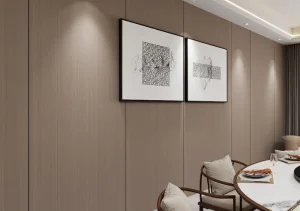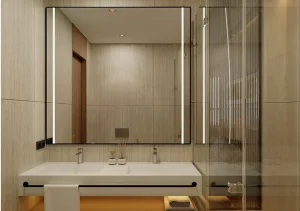Table of Contents
ToggleIntroduction
Acoustic panels have gained widespread popularity in modern construction due to their ability to improve sound quality, reduce noise pollution, and enhance aesthetics. As demand for high-performance acoustic solutions rises, contractors and wholesalers must stay informed about the latest industry trends to remain competitive. This article explores key developments shaping the acoustic panel market, offering insights into materials, technology, applications, and future innovations.

Trends About Acoustic Panels
1. Sustainable & Eco-Friendly Materials
With increasing emphasis on environmental responsibility, sustainable acoustic panels have become a top trend. Manufacturers are shifting towards eco-friendly materials such as:
- Recycled PET: Made from plastic bottles, these panels offer excellent sound absorption while reducing plastic waste. They are lightweight, durable, and available in various designs.
- Bamboo Charcoal Wood Veneer: Known for its durability and natural aesthetic, this material is gaining traction due to its moisture resistance, anti-microbial properties, and ability to regulate humidity.
- Hemp & Wool-Based Panels: Renewable, biodegradable, and providing superior acoustics, these panels offer an alternative to synthetic materials while maintaining excellent noise reduction performance.
- Cork & Wood Fiber Panels: Sourced from sustainable forestry, these panels are lightweight and efficient in noise reduction. They are also fire-resistant and moisture-resistant, making them ideal for various applications.
Wholesalers looking to appeal to environmentally conscious clients should prioritize sourcing and distributing sustainable options. Certifications like LEED (Leadership in Energy and Environmental Design) can add value and credibility to these products.
2. Customization & Aesthetic Appeal
Acoustic panels are no longer just functional; they are now an integral part of interior design. Contractors and wholesalers are witnessing a growing demand for:
- Custom Colors & Patterns: Clients want panels that match their brand identity or interior decor. Options include vibrant colors, geometric patterns, and corporate branding.
- 3D Acoustic Panels: These add depth and style while effectively managing sound. Their unique designs make them suitable for upscale corporate offices, hotels, and commercial spaces.
- Printed Acoustic Panels: Featuring logos, images, or artistic designs, these panels are popular in corporate and commercial settings. They are often used in restaurants, theaters, and retail stores.
- Modular & Interchangeable Panels: Allowing for easy reconfiguration to fit different spaces and styles, these panels provide flexibility in design and application.
- Perforated Acoustic Panels: These panels combine aesthetic appeal with high-performance sound absorption, often used in auditoriums, conference rooms, and music studios.
3. Multi-Functional Acoustic Panels
In modern construction, multi-functionality is highly valued. Recent innovations in acoustic panel design integrate additional features such as:
- Lighting Integration: Panels embedded with LED lighting to enhance ambiance and provide additional functionality.
- Smart Panels: Equipped with sensors to monitor and adjust sound levels, these panels are ideal for smart building integration.
- Fire-Resistant Panels: Essential for safety compliance in commercial buildings, these panels meet fire safety standards while providing excellent acoustic performance.
- Moisture-Resistant Panels: Suitable for high-humidity areas like gyms, swimming pools, and kitchens, these panels prevent mold and mildew growth.
- Air-Purifying Panels: Some modern panels incorporate air-filtering technology to improve indoor air quality while managing noise.
These advancements provide added value to clients, making them an attractive option for contractors and wholesalers.

4. Advancements in Acoustic Technology
Technological innovations are transforming the acoustic panel industry, leading to improved performance and efficiency. Some notable developments include:
- Nanotechnology Coatings: Enhancing durability, stain resistance, and sound absorption, nanotechnology-based coatings are being widely adopted for high-traffic environments.
- Active Noise Control (ANC) Panels: Using electronic components to cancel out unwanted noise, these panels are ideal for high-noise environments like airports and factories.
- AI-Based Acoustic Solutions: Analyzing noise levels and adjusting panel performance in real-time, these systems optimize acoustic conditions in dynamic environments.
- 3D-Printed Acoustic Panels: Enabling highly customized designs with superior sound control, 3D-printed panels are revolutionizing the industry by allowing precise tuning of acoustic properties.
As these technologies become more accessible, contractors and wholesalers should explore partnerships with innovative manufacturers.
5. Growing Demand in Various Applications
The market for acoustic panels is expanding beyond traditional office spaces and recording studios. Key sectors driving growth include:
- Commercial Buildings: Open-plan offices, conference rooms, and coworking spaces require advanced acoustic solutions to enhance productivity and reduce noise distractions.
- Educational Institutions: Schools and universities are investing in acoustic treatments to create better learning environments, improving speech clarity and concentration.
- Healthcare Facilities: Hospitals and clinics need soundproofing solutions to maintain patient privacy, reduce stress levels, and enhance overall well-being.
- Residential Spaces: Home theaters, apartments, and luxury homes are incorporating acoustic panels for improved living comfort and noise reduction.
- Industrial & Manufacturing: Factories and warehouses require noise-reducing solutions to meet occupational safety standards and improve worker comfort.
- Hospitality Industry: Hotels, restaurants, and entertainment venues are integrating acoustic solutions to enhance customer experience and prevent noise complaints.
Understanding these market segments helps wholesalers target the right clientele and expand their business reach.
6. Regulations & Compliance Standards
As acoustic solutions become a necessity in many industries, regulations are evolving to ensure quality and safety. Contractors and wholesalers must stay informed about:
- ISO & ASTM Standards: Governing sound absorption, fire safety, and environmental impact.
- LEED & Green Building Certifications: Encouraging the use of sustainable materials and energy-efficient solutions.
- Local Building Codes: Varying requirements for different regions and applications that impact material selection and installation procedures.
- Occupational Noise Standards: Compliance with workplace noise regulations ensures that industrial and commercial clients meet safety requirements.
By offering products that comply with these standards, wholesalers can enhance their credibility and attract large-scale projects.
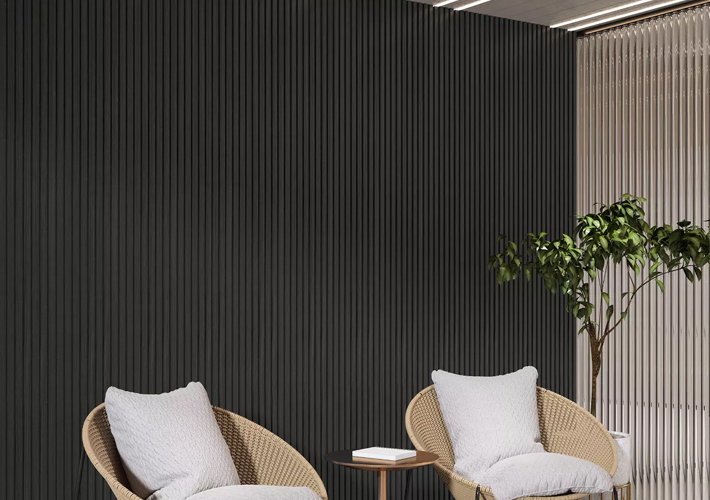
7. Competitive Pricing & Supply Chain Considerations
Price fluctuations and supply chain challenges affect the acoustic panel market. Key factors influencing pricing include:
- Raw Material Costs: Fluctuations in prices of wood, PET, and other materials impact overall costs and profit margins.
- Logistics & Shipping: Delays and rising freight charges can affect delivery times, making it crucial to establish reliable supply chain partnerships.
- Bulk Ordering & OEM Services: Offering customizable solutions at competitive rates can help wholesalers maintain profitability and attract international buyers.
- Direct Factory Partnerships: Collaborating with reliable manufacturers ensures steady supply, cost efficiency, and better product customization.
Contractors and wholesalers should optimize their procurement strategies to mitigate supply chain risks and offer competitive pricing.
8. Future Market Outlook
The acoustic panel industry is projected to continue growing, driven by increasing urbanization, workplace transformation, and technological advancements. Emerging trends to watch include:
- AI-Powered Sound Management Systems: Automating noise control in smart buildings.
- Hybrid Acoustic Panels: Combining sound absorption with decorative elements.
- Recyclable & Biodegradable Panels: Further advancements in sustainable options.
- Global Expansion: Growing demand in developing countries presents new business opportunities.
Conclusion
For contractors and wholesalers, staying ahead of these trends is crucial to maintaining a competitive edge. From sustainable materials and aesthetic enhancements to advanced technology and regulatory compliance, the acoustic panel industry is evolving rapidly. By adapting to market demands and leveraging innovative solutions, businesses can position themselves as leaders in the growing acoustic solutions market.

